
We look at one of the country’s most controversial cases involving the prosecution of activists for animal rights. Earlier this year, six people were convicted for their role in a campaign to stop animal testing by the British scientific firm Huntingdon Life Sciences. The activists are with a group called Stop Huntingdon Animal Cruelty, or SHAC. We speak with Andrew Stepanian, one of the convicted members of the SHAC 7 on the day he heads to prison for a three-year sentence. [includes rush transcript]
We look at one of this country’s most controversial cases involving the prosecution of activists for animal rights. Earlier this year, six people were convicted for their role in a campaign to stop animal testing by the British scientific firm Huntingdon Life Sciences.
The activists are with a group called Stop Huntingdon Animal Cruelty, or SHAC. Unlike other cases, the activists were never accused of causing physical damage. Instead, they were convicted of targeting Huntingdon workers, shareholders, and associates by posting personal information about employees and their families on the internet. The case has drawn scrutiny from civil rights advocates who say groups like SHAC have been singled out because they campaign against major corporations. The FBI has called animal rights groups the nation’s number one domestic terror threat.
Our next guest is a SHAC 7 member whose jail term begins today. Andrew Stepanian has been sentenced to three years in prison–the maximum allowed under the Animal Enterprise Protection Act. He is the first SHAC 7 member to go to jail following the convictions. We also speak with Andrew Erba, one of the lead attorneys in the case.
- Andrew Stepanian, member of SHAC 7. He joins us on the line from Huntington, New York. More information at SHAC7.com.
- Andrew Erba, one of the lead attorneys in the SHAC 7 case. Speaking to us from Philadelphia.
Special thanks: Footage from a forthcoming documentary by Z-Axis Productions, produced by Andy Roth and Hal Weiss.
Transcript
AMY GOODMAN: Our next guest is a SHAC 7 member whose jail term begins today. Andrew Stepanian has been sentenced to three years in prison, the maximum allowed under the Animal Enterprise Protection Act. He is the first SHAC 7 member to go to jail following the convictions. He is speaking with us from Huntington, New York. We welcome you to Democracy Now!, Andrew Stepanian.
But before we begin, a warning for our television audience. We’ll be playing some graphic footage taken of lab tests inside the Huntingdon facility in 1997. The video led the British government to temporarily take away Huntingdon’s license.
We’re also joined by Andrew Erba. He has been one of the lead attorneys in the SHAC 7 case, and he joins us from a studio in Philadelphia. Andrew Stepanian, you are turning yourself in today. Explain what you were convicted of.
ANDREW STEPANIAN: I was convicted of one count of a numerous count indictment that came down on both myself and co-defendants, including the corporation Stop Huntingdon Animal Cruelty USA, to which I was not a member. I didn’t facilitate a website. But with the website, with the corporation and myself, all of these charges stem from speech-related activity, whether or not that was speech on internet or if it was speech engaged at a peaceful demonstration, most done with the oversight of police. And that’s where my charge came in.
I sat through a court case of about 40 days, and at the end of it, I was convicted, mainly on evidence stemming from my attendance at a protest against an auditing firm by the name of Deloitte & Touche. The prosecutors claim that because Deloitte & Touche severed its relationship with Huntingdon Life Sciences, Huntingdon Life Sciences may have incurred more than $10,000 in damages. And as long as a threshold of $10,000 is met, I could participate in legal activities leading up to that point, but the second I cause $10,000 of intellectual damage, then I could be charged under this conspiracy to violate the Animal Enterprise Protection Act. I would be charged with a substantive charge if I actually destroyed some property, for example, that was worth $10,000, but in this case, it was a purely intellectual matter.
And that demonstration, in particular, the Nassau County Police in Long Island appeared on the scene. They didn’t find any reason to cite any of the people in attendance of the demonstration, including myself, and I was more than open about my attendance at that demonstration. I had no idea that at the end of a 40-or-so-day trial, that that is why I’m going to end up serving 36 months in jail.
AMY GOODMAN: Your sentence was upped, because you had a party a few weeks ago, a going-away party?
ANDREW STEPANIAN: Yeah. My mother thought it was a good idea to have a going-away party for myself. I used to be a promoter in the punk rock scene a few years ago on Long Island. I also was a talent buyer at a club called The Downtown in Long Island, New York. And so, a bunch of bands got together and played a show in my backyard. And the best that I can make of it is that people that were like-minded got together, and there must have been some folks who decided to go out and do a demonstration that night.
Again, the demonstration wasn’t illegal. No property was damaged, but the fact that a demonstration happened on the same day as my going-away party, it warranted some response from the prosecution during sentencing, saying that I’m a lightning rod for this type of activity, and if I’m not a leader, that I should start acting like a leader and try to stop activism like this on Long Island. It’s my contention that at this point I’m being prosecuted as a leader, and I’m not a leader, and I’m not about to start becoming a leader in this movement and dissuade people from following their hearts and getting involved with activism that I think is righteous.
AMY GOODMAN: Andrew Stepanian, let me read you from the Southern Poverty Law Center intelligence report. It’s by Heidi Beirich and Bob Moser. Just the beginning of it.
ANDREW STEPANIAN: Okay.
AMY GOODMAN: It says, “A Chicago insurance executive might seem like one of the last people who’d be opening a letter with this succinctly chilling message: 'You have been targeted for terrorist attack.' But that’s what happened last year, when a top official at Marsh USA Inc. was informed that he and his company’s employees had landed in the crosshairs of an extremist animal rights group. The reason? Marsh provides insurance for one of the world’s biggest animal testing labs. 'If you bail out now,' the letter advised, 'you, your business, and your family will be spared great hassle and humility.'
“That letter — and the harassment campaign that followed, after Marsh declined to 'bail out' — was another shot fired by Stop Huntingdon Animal Cruelty (SHAC). This British-born group, now firmly established in the United States, is waging war on anyone involved with Huntingdon Life Sciences, which tests drugs on approximately 70,000 rats, dogs, monkeys and other animals each year. In the process, SHAC is rewriting the rules by which even the most radical eco-activists have traditionally operated.
“In the past, even the edgiest American eco-warriors drew the line at targeting humans. They trumpeted underground activists’ attacks on businesses and laboratories perceived as abusing animals or the environment — the FBI reports more than 600 incidents, causing $43 million in damage, since 1996. But spokespeople for the two most active groups in the U.S., the Animal Liberation Front (ALF) and the Earth Liberation Front (ELF), have always been quick to claim that their underground cells have never injured or killed any people.
“Since 1999, however, members of both groups have been involved with SHAC’s campaign to harass employees of Huntingdon — and even distantly related business associates like Marsh–with frankly terroristic tactics similar to those of anti-abortion extremists. Employees have had their homes vandalized with spray-painted 'Puppy killer' and ’We’ll be back’ notices. They have faced a mounting number of death threats, fire bombings and violent assaults. They’ve had their names, addresses and personal information posted on Web sites and posters, declaring them 'wanted for collaboration with animal torture.'
“When cowed companies began responding to the harassment by pulling away from Huntington, many radical environmentalists cheered–even when SHAC’s actions clearly went over the 'nonviolent' line.” Your response?
ANDREW STEPANIAN: My response to that is that historically, the animal rights movement still to date has never hurt anyone in the United States. And so, to somehow say that we’re at par with anti-abortion extremists is a bit of a stretch. Anti-abortion extremists obviously have hurt people. I can’t be the spokesperson for SHAC, SHAC USA Incorporated, and especially not the activities of SHAC in the UK. I was a volunteer with a group called the Animal Defense League of Long Island, and my involvement with SHAC began the second I was indicted with everybody else in accordance with this conspiracy.
All I could really say in regards to what you just repeated to me is that some of that seems grossly exaggerated. And that’s just from my experience with sitting in on this trial and the court record. I don’t recall at any point the prosecutors ever alleging or saying that a letter of that nature ever arose. And I was pretty attentive, taking notes the entire time during the trial. Also, there was never an incident of human-to-human violence that happened in the United States. The historical record will show that things like spray paintings did happen, and demonstrations happened out in front of people’s houses.
And, in fact, I think the most violent rhetoric that was read back into an email was something in regards to “How would you feel if someone treated your child the way these poor animals are being treated?” Later on, I read a New York Times article that showed that an FBI agent was misquoting that same exact quote that was given during testimony, that was alleged to have been in an email received from an anonymous individual, not SHAC or SHAC USA or SHAC UK or any of the parties sitting there in the court case, but rather an anonymous individual, saying, “How would you like it if your child was treated that way?” And that’s open to a great deal of speculation. You can go and say, alright, maybe someone’s trying to make someone feel empathy for an animal the way people feel empathy for a child. And there was a lot of room for argument, obviously, in the eyes of the prosecution.
But when it comes down to it, at the end of the day, no one was hurt. SHAC USA, on their website, never advocated for anyone to be hurt. SHAC USA, at the bottom of every page, when you load up the html, always had a disclaimer that said that we do not advocate any form of violent activity, and in fact, we urge people that when they write letters or they send emails, that they’re polite, they’re to the point, they’re not threatening in nature. And, obviously, all that happened on the SHAC USA website was a legal form of reporting. It wasn’t, “You go and go do this or go annoy these people or go harass these people,” but rather, “These are the people that are supporting this laboratory. This is how they put bread on the table. And this is how this company exists.” The website existed for a purpose, to say, “This company is an organism. And there are different things that feed this organism and keep it alive.”
Whether or not people took that information and did less than savory things or things that even made myself feel uncomfortable, well, that wasn’t necessarily the business of SHAC USA to be responsible for. The only business that they had was reporting on the facts. And all that, no matter how uncomfortable you might say it is, is protected underneath the First Amendment.
AMY GOODMAN: Andrew Stepanian, speaking to us before he turns himself in today. And, Andrew, let me say that I was reading to you from a fall 2002 article, which doesn’t specifically describe the case that you were involved with. Andrew Erba also joins us from Philadelphia, Andrew Stepanian’s lawyer. Can you put SHAC 7, this case, in the context of other conspiracy cases?
ANDREW ERBA: Well, actually, it’s very important piece of legal actions, because it moves the internet into prosecution. I mean, really what is being prosecuted here is, as Andy said, the posting of notices, the posting of news, the exchange of emails on an internet website. The government says that as a result of this posting of information, which otherwise, I think, is completely legal and First Amendment-protected, other individuals were incited to take actions. But the government has never proven any individual actually read the information on the website and then took an immediate action based on that, which is the test under Brandenburg v. Ohio.
And so, what we have is a very important extension of a constitutional doctrine into an area, which I think affects many activist groups, because, certainly, if we look on the web today, on the internet, many people hold websites which say things which may be somewhat rhetorical, may be somewhat passionate, and as a result of posting that, if someone should act on that, should that website, should that activist group be held responsible? I think not, under the First Amendment.
AMY GOODMAN: Andrew Erba, can you compare the Animal Enterprise Protection Act, an industry-specific statute that provides harsher sentences for those protesting animal-related businesses than perhaps those protesting women’s health clinics around the issue of abortion?
ANDREW ERBA: One of the things we have to understand is that — and this is one of our arguments, will be in the Third Circuit — that the government is really misconstruing the Animal Enterprise Protection Act. It’s a very specific act, and what it really prohibits is someone who would go on the property of an animal enterprise and free an animal that’s in an experiment or break a window or knock down a door — I mean, do something physically in a trespass action.
Now, what the government has done in this case is transmute that into an action which says that if I organize activities, which may lead to someone organizing against an animal enterprise, they’re held responsible. And this is in direct contradiction to the legislation under the abortion statutes or the anti-abortion statutes, to really talk about a specific action, a person picketing an abortion clinic, a person preventing a woman from entering an abortion clinic. So, in one sense, the government has accepted that it has to have a greater nexus, but with the Animal Enterprise Protection Act, they’ve lost that nexus and really are prosecuting people who merely advocate having a movement against the various animal enterprise. And so, therefore, we feel it’s a gross extension of what Congress intended under the act.
AMY GOODMAN: Andrew Stepanian, if you had this all to do again, would you do it differently?
ANDREW STEPANIAN: I would have to say no. I mean, I have a minimal involvement with this, from start to finish. And my only involvement was with the Animal Defense League of Long Island, a group that’s been acclaimed by local politicians. I recently got an award from both the U.S. military and the United States Humane Society for my work down in New Orleans helping right after Hurricane Katrina. And, you know, it’s like, these are activities that I partake in with my affinity group and my activists in Long Island, and I’m proud to be working with them. What motivated us to help the people down in New Orleans is exactly what motivated us to get involved with, you know, picketing Deloitte & Touche, saying that they shouldn’t support the murder of 180,000 animals each day.
And with closing that, you know, I think that what scares me is that it doesn’t end here. Currently, the Senate subcommittee hearings that are trying to broaden these laws and have them go after other specific focus activist groups. And if I can quote Senator James Inhofe, a Republican from Oklahoma, dated October 26 of 2005, he says, “It seems to me unimaginable that this country’s worldwide symbol of the integrity of capital markets, the New York Stock Exchange, would capitulate to threats, or in this case even the mere threat of threats from a single-issue extremist group. Appeasing these groups only validates their effectiveness and the effectiveness of their tactics and inspires them to replicate this model of activism in some sort of other venue. What then happens when the activists move to the timber, the defense or some sort of other controversial industry?”
And I interpret that and that entire Senate subcommittee hearing as, they don’t want effective models of activism, like the Stop Huntingdon Animal Cruelty campaign, to be applied to antiwar activism, to be applied to women’s health issues, to be applied to civil rights issues, to be applied to — for example, in great model would be organizing against sweatshops.
And this is something that obviously is important to me, and I am ready to go to the Third Circuit. I’m ready to appeal. And I’m ready to win on this issue, because I think that at the end of the day, I’m not willing to have my name brought up in the middle of a battle that loses and thus chills free speech for all types of people that believe in all different kinds of issues around this country, even issues I don’t agree with. I want people to have that freedom to go do what they want to do.
AMY GOODMAN: Andrew, how old are you?
ANDREW STEPANIAN: 28 years old. I’m going to be 31 when I get out. Obviously, it’s stressful. www.shac7.com is a website where people can get in touch with how to write us letters or how to donate to legal defense, and it has not only bios on myself, but my other co-defendants, great individuals like Kevin Kjonaas, Lauren Gazzola, Darius Fulmer, Jacob Conroy and Josh Harper. They all could use letters, when we’re all in jail. And we obviously want to thank our supporters that are out there.
AMY GOODMAN: And where will turn yourself in?
ANDREW STEPANIAN: I’m turning myself in on Cadman Plaza West today at the U.S. courthouse. I’m going to be meeting up with some U.S. marshals there. And I do believe that they are going to be taking me to the Metropolitan Detention complex in Brooklyn.
AMY GOODMAN: I want to thank you for joining us, Andrew Stepanian and Andrew Erba, your attorney, joining us from Philadelphia.


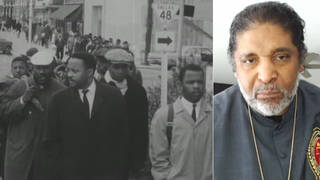
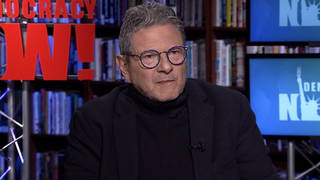

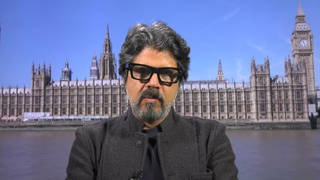

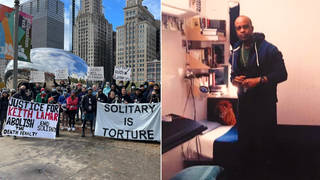



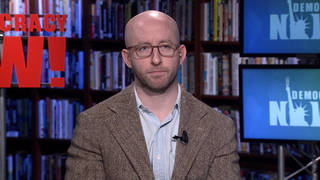
Media Options